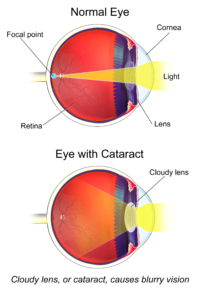Cataracts: Symptoms, Treatment and Reducing Your Risk

June is Cataract Awareness Month. A cataract is a clouding of the eye’s lens that causes loss of vision, the most common type being age related. Cataracts are the leading cause of reduced vision in adults 55 and older, so it’s important to know the facts because there’s a lot that can be done to treat this condition and reduce your risk of developing cataracts.
As we age, some of the naturally occurring protein in the lens of our eyes begins to clump together, clouding a small area of the lens. This is the beginning of a cataract, which initially may not be noticeable. Over time, however, the cataract may grow larger, making it harder to see. The most common symptoms of a cataract include:
- Cloudy or blurry vision.
- Colors seem faded.
- Headlights, lamps or sunlight may appear too bright, and halos may appear around lights.
- Poor night vision.
- Double vision or multiple images in one eye.
- Frequent prescription changes in your eyeglasses or contact lenses.
If you’re experiencing any of these symptoms, you may have cataracts or another eye problem. You will need a comprehensive eye exam that includes a visual acuity test, a dilated eye exam, tonometry (a test that measures eye pressure) and possibly other tests to evaluate the structure and health of your eyes.
Some of my patients with early cataracts have improved with new eyeglasses, brighter lighting, and anti-glare sunglasses. When these strategies don’t help and if the patient is struggling to see in daily activities, I refer him or her to an opthalmologist who specializes in cataract surgery. Surgery involves removing the cloudy lens and replacing it with an intraocular lens, which improves vision in more than 90 percent of patients.
While you’re more likely to develop cataracts as you age, you can take steps to reduce your risk by making the following lifestyle changes:
- Reduce or quit smoking.
- Avoid alcohol or use it in moderation.
- Maintain a healthy diet rich in antioxidants, such as beta-carotene, selenium and vitamins C and E — or add these vitamin supplements to your diet.
- Shade your eyes with sunglasses that provide UVA/UVB protection.
- See your eye doctor every year for an eye exam, which includes looking for signs of cataracts, glaucoma, macular degeneration and other vision disorders.
If you or a loved one is having vision problems, give us a call at 860-763-4733. Early detection can be a sight saver!